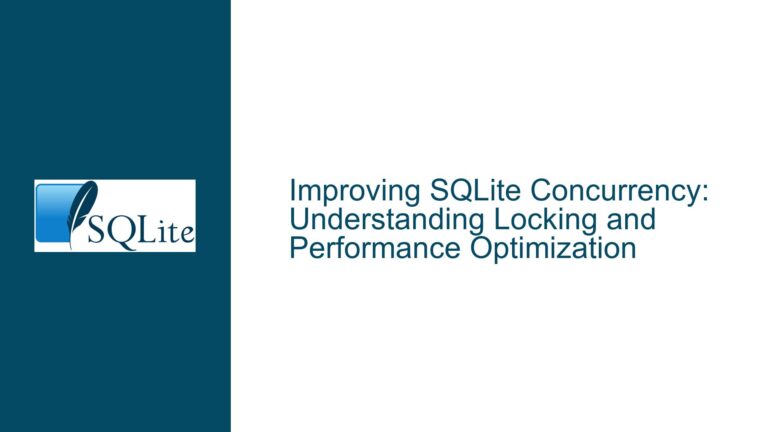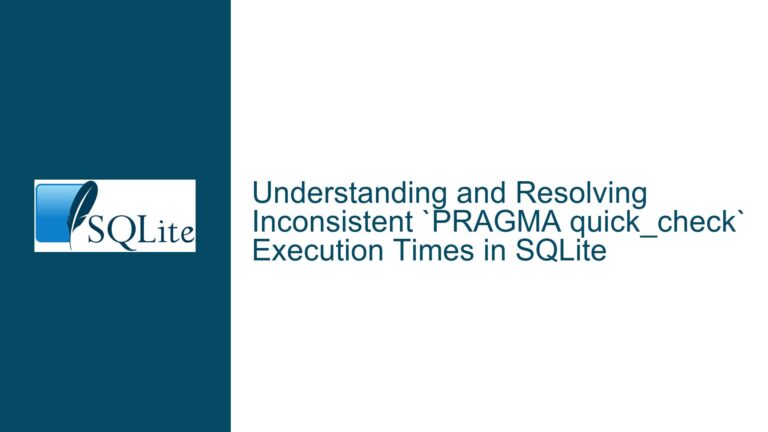and Resolving SQLite BestIndex Constraints in JOIN Queries
Issue Overview: BestIndex Constraints in JOIN Queries and Their Impact on Query Performance
When working with SQLite, particularly in the context of virtual tables and JOIN operations, the BestIndex function plays a critical role in determining the most efficient query execution plan. The BestIndex function is responsible for evaluating the constraints applied to a query and deciding how to best utilize available indexes to minimize the cost of query execution. However, in complex JOIN scenarios, the distinction between constraints that limit the result set and those that define the relationship between joined tables can become blurred, leading to suboptimal query plans.
In the provided scenario, we have two virtual tables, privilege and assmnt, each with a unique index defined on a combination of columns. The query in question involves a JOIN between these two tables, with several constraints applied to filter the results. The BestIndex function is called multiple times, each time with different sets of constraints, and the resulting query plans vary significantly in terms of cost and efficiency.
The core issue revolves around the inability of the BestIndex function to distinguish between constraints that are meant to limit the result set (e.g., a.state_def_no = 13) and those that are part of the JOIN condition (e.g., p.module_def_no = a.module_def_no). This lack of distinction can lead to inefficient query plans, such as full table scans or partial key scans, where a more optimal plan could have been chosen if the constraints were correctly interpreted.
Possible Causes: Misinterpretation of Constraints in JOIN Operations
The root cause of the issue lies in how SQLite’s query planner interprets and prioritizes constraints during the BestIndex function call. Specifically, the following factors contribute to the problem:
Ambiguity in Constraint Types: SQLite does not inherently differentiate between constraints that limit the result set and those that define JOIN conditions. This ambiguity can lead to the query planner making suboptimal decisions, especially when multiple constraints are involved. For example, in the query
SELECT ... FROM privilege p, assmnt a WHERE a.state_def_no = 13 AND p.module_def_no = a.module_def_no, the constrainta.state_def_no = 13is a result set limiting constraint, whilep.module_def_no = a.module_def_nois a JOIN constraint. However, SQLite treats both constraints similarly, which can result in inefficient query plans.Index Utilization: The
BestIndexfunction relies on the available indexes to determine the most efficient query plan. However, when constraints are misinterpreted, the function may not utilize the indexes effectively. For instance, in the provided scenario, theBestIndexfunction initially uses the full index on theprivilegetable when all constraints are available, resulting in a low-cost plan. However, when only the JOIN constraints are available, the function resorts to a full table scan, significantly increasing the query cost.Query Plan Selection: SQLite’s query planner may choose a query plan that favors one table over another based on the order of constraints. For example, if the query is written as
T1.a == x AND T1.a == T2.a, the planner may favorT1in the outer loop, whereasT2.a == x AND T1.a == T2.amay favorT2. This can lead to different query plans with varying levels of efficiency, depending on how the constraints are structured.Omission of Constraints: In some cases, the
BestIndexfunction may omit certain constraints if they are not deemed useful for index selection. This can happen when the constraints are not directly related to the indexed columns or when the constraints are part of a complex expression. For example, in the provided scenario, the constraintp.write_access_allowed = 1is omitted in someBestIndexcalls, which may affect the overall query plan.
Troubleshooting Steps, Solutions & Fixes: Optimizing BestIndex for JOIN Constraints
To address the issue of misinterpreted constraints in JOIN queries, the following steps can be taken to optimize the BestIndex function and improve query performance:
Explicitly Define Constraint Types: One approach is to explicitly define the types of constraints within the
BestIndexfunction. This can be done by extending the SQLite virtual table interface to include additional metadata about the constraints. For example, a custom virtual table implementation could include a flag or attribute that indicates whether a constraint is a result set limiting constraint or a JOIN constraint. This information can then be used by theBestIndexfunction to make more informed decisions about index utilization.Prioritize Constraints Based on Query Structure: Another approach is to prioritize constraints based on their role in the query. For instance, JOIN constraints should be given higher priority when determining the query plan, as they directly affect the relationship between the tables being joined. This can be achieved by modifying the
BestIndexfunction to assign different weights to constraints based on their type. For example, JOIN constraints could be assigned a higher weight than result set limiting constraints, ensuring that they are considered first when selecting an index.Optimize Index Selection for JOINs: The
BestIndexfunction should be optimized to select indexes that are most beneficial for JOIN operations. This can be done by evaluating the selectivity of the constraints and choosing indexes that reduce the number of rows to be joined. For example, if a JOIN constraint involves a highly selective column (e.g., a unique identifier), theBestIndexfunction should prioritize using an index on that column to minimize the number of rows that need to be processed.Use Query Rewriting to Improve Plan Selection: In some cases, rewriting the query can lead to better query plans. For example, rewriting the query to use a different form of the JOIN condition (e.g.,
T1.a == x AND T2.a == xinstead ofT1.a == x AND T1.a == T2.a) can influence the query planner to choose a more efficient plan. This approach requires careful analysis of the query and its constraints to ensure that the rewritten query produces the same results as the original.Analyze and Adjust Query Plan Costs: The
BestIndexfunction uses cost estimates to determine the most efficient query plan. These cost estimates can be adjusted to better reflect the actual cost of different query plans. For example, if a full table scan is being chosen over an index scan due to incorrect cost estimates, the cost of the full table scan can be increased to encourage the use of the index. This can be done by modifying the virtual table implementation to provide more accurate cost estimates based on the specific constraints and indexes available.Implement Custom Filter Functions: In some cases, it may be necessary to implement custom filter functions to handle complex constraints. These custom functions can be designed to evaluate constraints more accurately and provide better guidance to the
BestIndexfunction. For example, a custom filter function could be implemented to handle constraints involving multiple columns or complex expressions, ensuring that they are properly considered during index selection.Monitor and Analyze Query Performance: Finally, it is important to continuously monitor and analyze query performance to identify any issues with the
BestIndexfunction. This can be done using SQLite’s built-in query plan analysis tools, such as theEXPLAIN QUERY PLANstatement. By regularly reviewing query plans and performance metrics, any inefficiencies in theBestIndexfunction can be identified and addressed promptly.
In conclusion, the issue of misinterpreted constraints in JOIN queries can significantly impact query performance in SQLite. By understanding the underlying causes and implementing the above solutions, it is possible to optimize the BestIndex function and ensure that the most efficient query plans are chosen. This will result in faster query execution times and improved overall database performance.






